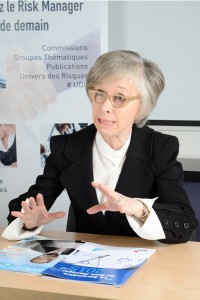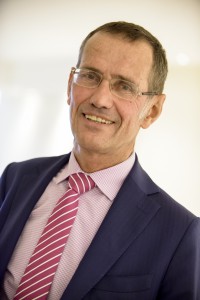During the last annual conference of the French association AMRAE in Lille last February, the President of AMRAE Brigitte Bouquot and FERMA President Jo Willaert shared their views on the need for a sense of urgency in managing risks which are today systemic and inter-connected.

Brigitte Bouquot, AMRAE President and Director of Insurance and Risk Management at Thales
FERMA: In terms of AMRAE’s relationship with Europe, what are your priorities?
Brigitte: Solvency II is certainly something which we have followed closely. We see that large insurers are very prudent. They are taking time to discuss risks, to do their scenarios. They are taking more time to make decisions. At the same time, I believe that the current process of consolidation in the insurance market is positive for risk managers. The risk carriers have become very powerful which is good for us because risks are becoming extreme. We are looking for insurers which can offer truly global programmes and are very powerful.
We are also aware that there are enormous implications for French enterprises in developments related to data privacy, the end of safe harbour provisions for data transfer and other cyber risks. I think the legal landscape for business in Europe has become more demanding for these issues, and there are others such as the use of drones, where companies are expected to anticipate more and not wait for the European Commission to act.
Jo: The consolidation in the insurance market reflects the development of industry generally, but the market is large and there aren’t monopolies. Among the large, global insurers, there are still sufficient for us to choose from, and the capacity is now enormous. I think this regrouping is also a good thing in terms of the quality of these large insurers and the expertise they can offer.
Brigitte: Insurance is a business of people. With mergers, there is an increase of capacity and expert capability, but there is a risk of losing expertise and knowledge if key people leave.
Jo: There is an advantage in the larger number and the wider skills of the people working in these companies. I think this consolidation reinforces the profession and deepens the knowledge available. They are already at a high level and will improve still further as mergers bring them together.
FERMA: Has Solvency II been a big issue in terms of captives for AMRAE members?
Brigitte: Yes and no. Everyone has done what they needed to do for Solvency II. It was primarily an administrative process. It did require work, and there were some difficult decisions to be made. It was most profound in terms of risk of underwriting, governance, and some corrections to elements of the accounts. But it was not an expensive exercise in terms of capitalisation.
Jo: It was no more difficult than it was for a commercial insurer, but it did make companies reflect before starting a new captive.
Brigitte: There is something interesting for industrial or commercial enterprises. You have a model of risk which is very operational. Then when you try to apply this approach to insuring the enterprise, it seems that sometimes the company’s idea of enterprise risk may not be the same as that of the insurers.

Jo Willaert, FERMA President and Agfa Gevaert Risk Manager
Jo: If you have applied Solvency II for your captive, then you have an insight into the insurers’ spirit of governance. Solvency II has had advantages for us all. Everyone who bears risk had to reflect.
Brigitte: This is been an evolution, not revolution. Whether or not to have a captive is a strategic decision, not one for an overnight decision. A captive is still a useful tool if you want to be more creative or imaginative in your risk transfer projects, but it requires consideration.
FERMA: Of two big risks, cyber and climate change, which do risk managers see as more of a concern?
Brigitte: Cyber. Without minimising the potential impact of climate change, even with risks such as more intense storms, there is still a continuity. These are risks which we already manage and ones for which insurers know how to find solutions. The mechanisms are in place and they are robust. Cyber is much more difficult because there are many possible loss scenarios, loss of data, denial of service attacks and so on, and they are continually changing. This is very challenging.
Jo: The mechanism of underwriting catastrophe risks is not different in nature to what it has been, although we have to adapt to the circumstances. With cyber-related risks, we have different types of exposure: first party and third party, liabilities and non-damage business interruption. More and more, the risks are interlinked. The underlying problem can be an IT one, but it comes with the problem of reputation, communication and crisis management, for instance. The great challenge for insurers is to overcome the restrictions of their traditional classes of underwriting, so that we can have contingent business interruption cover across different lines of business.
FERMA: What is your working relationship like with the insurance industry?
Brigitte: We want insurers to understand that they should be more creative in matching their solutions to the needs of their clients. We have to do this quickly because risk is going to increase very quickly. My desire is that everyone is motivated and takes this changing situation to heart. Insurers need to be aware that their image with boards has to be reinforced continuously.
Jo: Boards and top managers of companies only tend to come into contact with insurance when there is a problem, when they have a risk which isn’t covered. They don’t often see insurers as collaborators, but as vendors of policies. They are more inclined to see banks as collaborators, as partners, even though insurers came out of the financial crisis in much more robust shape than banks.
Brigitte: It is the job of the risk manager to tackle subjects which are taboo. We have to take those subjects and work on them. Risks evolve. If insurers’ products do not adapt accordingly, their image could suffer.
Jo: We believe recognition of the function of risk management is so important in this context because the profession knows what products are available and has creative ways to find other solutions. We have to be able to present them to the board, using the right language and setting them in the context of the business plans.
FERMA: How can FERMA best help AMRAE and its members?
Brigitte: FERMA is very important because it is always a way we can learn from a European perspective. As a means to collaborating, great expertise, this is really something very useful. FERMA helps associations to create a network. We also appreciate FERMA’s lobbying function with the EU and in terms of working with North American and Asian organisations.
I believe that the ‘job’ of the risk manager must be more professional, so AMRAE is an enthusiastic supporter of FERMA’s certification programme, rimap©. Let’s remember that AMRAE initiated the first risk manager framework in 2014, which was translated in English in 2015 in order to be shared with every national organisation. I am glad to see how it helped to set up rimap.
AMRAE is very focussed on continuing professional development and recognition for risk managers. We have been involved with risk management training and education programmes developed in different countries, but rimap is a project for all European countries. FERMA is dedicated to developing a standard that has global recognition, so that for example, an Indian CEO understands what it means to be a rimap certified risk manager. This is a long term, strategic project.